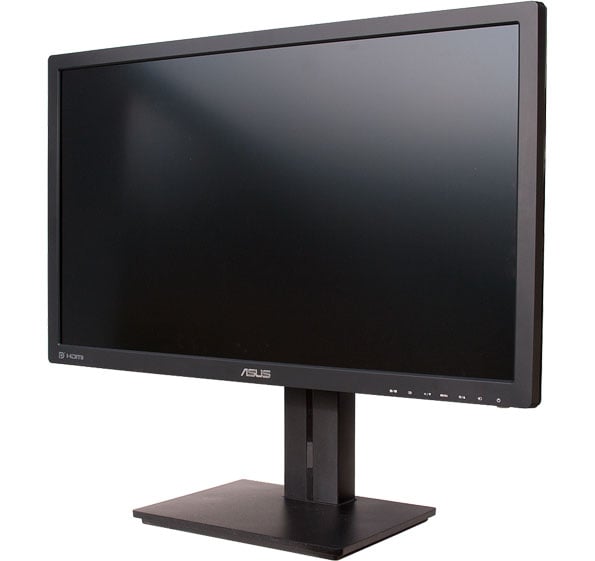ASUS PB278Q 27-inch WQHD Monitor Review
Design
The PB278Q is the inaugural model in ASUS' new PB Series, though you may recognized it as the VA278Q. According to ASUS, the PB278Q isn't a simple rebranding, it's an upgraded panel with "professional-quality enhancements" and pre-calibration at the factory.


One of the first things we noticed about the PB278Q is that it's big without the bulk. By that we mean it's a sizable monitor, and definitely eye-catching, but it doesn't necessarily dominate the desktop the way most 30-inch panels do, and considerably lighter. In terms of hard numbers, it measures 25.3 inches (W) by 21.7 inches (H) by 8.6 inches (D) and weighs 19.4 pounds. To put that in perspective, HP's ZR30w weights 28.6 pounds.
ASUS chose not to surround the PB278Q with a glossy bezel, a wise decision considering the target audience includes graphics professionals who are likely to frequently tinker with the onscreen controls. It's a rather attractive, if not understated monitor with a fairly thin bezel measuring about three-fourths of an inch thick on the top and sides, and a full inch along the bottom. A silver "ASUS" logo adorns the bottom bezel in the middle.
Behind it all is an 8-bit PLS panel built by Samsung. It has a native resolution of 2560x1440 with a 5ms response time (gray-to-gray), 80,000,000:1 "Smart" contrast ratio, 300 cd/m2 brightness rating.

ASUS chose not to surround the PB278Q with a glossy bezel, a wise decision considering the target audience includes graphics professionals who are likely to frequently tinker with the onscreen controls. It's a rather attractive, if not understated monitor with a fairly thin bezel measuring about three-fourths of an inch thick on the top and sides, and a full inch along the bottom. A silver "ASUS" logo adorns the bottom bezel in the middle.
Behind it all is an 8-bit PLS panel built by Samsung. It has a native resolution of 2560x1440 with a 5ms response time (gray-to-gray), 80,000,000:1 "Smart" contrast ratio, 300 cd/m2 brightness rating.

Even professional (or semi-professional) grade monitors are featuring thinner profiles these days, though they're not on par with some of the super skinny LED displays out there. The frame on the PB278Q is about an inch wide along the edge, and up to around 2 inches deep in the middle where it bows out the most.
A semi-glossy strip of plastic surrounds the back of the bezel all the way around the monitor, giving it an attractive two-tone finish. And though it's glossy, it's thin enough not to pose a problem with fingerprints.
The slightly rectangular base pivots 360 degrees, a welcome feature when you need to twist and turn the monitor to show a co-worker or roommate what's on the screen. It's made of plastic, and so is the thick and sturdy neck, which feels like a brick. It all adds up to an able-bodied foundation that feels anything but flimsy.
You can tilt the monitor from +20 degrees to around -5 degrees and, as we'll show in a moment, swivel/rotate into landscape or portrait mode. All told, this is one of the more flexible monitors out there.
One thing the stand is missing, however, is any type of cable management scheme, if that's of any importance to you.
One of the major knocks against the PB278Q is that it doesn't have a built-in USB hub or, perhaps more importantly for graphics professionals and digital media enthusiasts, a media card reader. The most important part of a monitor is, of course, the actual display, but these types of missing conveniences can tip the scales in a crowded market.
While the PB278Q lacks the above amenities, it does come equipped with nice selection of ports. From left to right, they include:
A semi-glossy strip of plastic surrounds the back of the bezel all the way around the monitor, giving it an attractive two-tone finish. And though it's glossy, it's thin enough not to pose a problem with fingerprints.
The slightly rectangular base pivots 360 degrees, a welcome feature when you need to twist and turn the monitor to show a co-worker or roommate what's on the screen. It's made of plastic, and so is the thick and sturdy neck, which feels like a brick. It all adds up to an able-bodied foundation that feels anything but flimsy.
You can tilt the monitor from +20 degrees to around -5 degrees and, as we'll show in a moment, swivel/rotate into landscape or portrait mode. All told, this is one of the more flexible monitors out there.
One thing the stand is missing, however, is any type of cable management scheme, if that's of any importance to you.
One of the major knocks against the PB278Q is that it doesn't have a built-in USB hub or, perhaps more importantly for graphics professionals and digital media enthusiasts, a media card reader. The most important part of a monitor is, of course, the actual display, but these types of missing conveniences can tip the scales in a crowded market.
While the PB278Q lacks the above amenities, it does come equipped with nice selection of ports. From left to right, they include:
- Kensington lock slot
- AC-IN port
- DisplayPort
- VGA port
- DVI-D port
- DHMI port
- Audio Line-in port
- Earphone jack
Gamers have little use for rotating a monitor into Portrait mode, but it can an uber useful function for graphics professionals, productivity gurus, and power surfers alike. The PB278Q accommodates such users by being able to pivot/rotate 180 degrees. In Landscape mode, the ability to pivot is slightly rigid at first, a feature that prevents you from accidentally rotating the monitor all the time.









